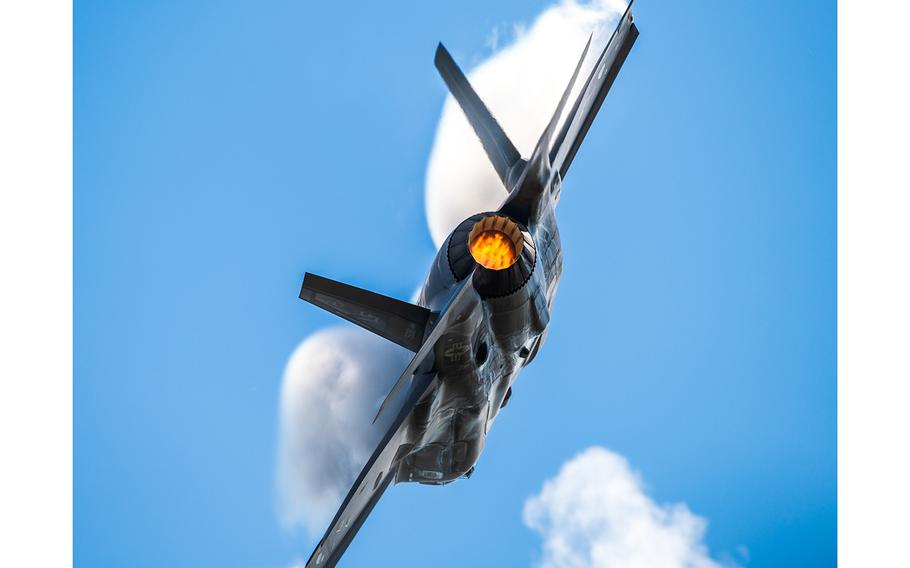
An F-35 performs aerial maneuvers during an airshow Oct. 18, 2019, in Houston, Texas. (Alexander Cook/U.S. Air Force )
WASHINGTON — The Pentagon has agreed to purchase hundreds more F-35 Lightning II aircraft from Lockheed Martin for the Air Force, Navy, Marine Corps and international partner nations even as a shortage of spare parts have kept the costly fighter jets from achieving combat readiness goals.
Top Pentagon officials announced Tuesday that the military would buy another 478 F-35 Joint Strike Fighters in a $34 billion deal that will reduce the average cost of the aircraft about 12.7% in three installments of aircraft deliveries. The purchase announced is the biggest yet for the F-35 program, the Pentagon’s most expensive-ever weapons program that has faced criticism for years over delays, cost overruns and problems that have grounded jets delivered to the military.
“I have full faith and confidence in the F-35 program and our ability to deliver F-35 combat capability anywhere in the world,” Ellen Lord, the Pentagon’s top acquisition official, told reporters at the Pentagon. “Make no mistake, the F-35 is the world’s most advanced, lethal and interoperable aircraft ever developed.”
The new contract covers three upcoming batches — called lots — of aircraft to be delivered to the U.S. and partner militaries. The first batch will include 149 jets, the second 160 and the third 169 fighters.
But the F-35 program has continued to face problems, including its failure this year to reach the goal set last year by then-Defense Secretary Jim Mattis for all variants of the U.S. fighter aircraft to achieve 80 percent of aircraft available to fly combat missions at any given time. In September, U.S. F-35s reached a 73% mission-capable rate, up from about 55% one year earlier, said Air Force Lt. Gen. Eric T. Fick, the chief of the Pentagon’s F-35 program.
“We have definitely moved and continue to move the needle,” he said.
The problems hindering the F-35 program from reaching those combat readiness goals lie primarily with a shortage of spare parts, Fick said, especially in three areas — issues with a shortage of replacements for the stealth coating on the jets’ canopies, engine fuel hydraulic tubes and wing-tip light lenses.
The Government Accountability Office warned in April that the Pentagon was removing spare parts from some of its existing planes to keep others flying. Lord said the military was improving and working with Lockheed Martin to increase the number of spare parts available, which has helped to increase the combat readiness numbers.
“We believe we are making very good progress and moving forward,” Lord said.
The cost of the F-35A — the traditional take-off and land variant of the Joint Strike Fighter flown by the Air Force and international partners including Israel, Italy and the United Kingdom — will fall below $80 million per aircraft for the first time in the new contract’s final batch. The aircraft is also built in two other variants: the F-35B, which can take off on a short runway and land vertically like a helicopter and is flown by the Marine Corps, and the F-35C, flown by the U.S. Navy and designed to be used from aircraft carriers. The Marine version is the most expensive and will fall to just more than $101 million per plane by the final lot announced Tuesday. The Navy’s version will cost almost $94.5 million per plane by that final batch, the Pentagon said.
Lockheed Martin began production of the F-35 in 2006, and is expected to produce some 2,456 fighter jets for the U.S. military in a program expected to cost more than $400 billion.
The F-35 was first used in combat in September 2018, when Marine pilots engaged targets in Afghanistan. The Air Force has also used its version in combat more recently in Iraq and Syria. Israel was the first to announce the use of an F-35 fighter in combat, saying it used its F-35As for a pair of strikes in Syria in May 2018.
dickstein.corey@stripes.com Twitter: @CDicksteinDC